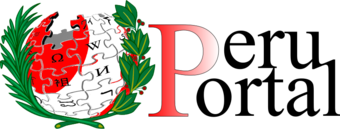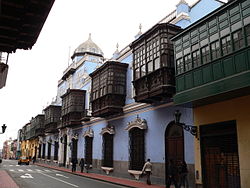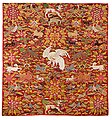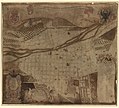Portal:Peru
Introduction
Peru, officially the Republic of Peru, is a country in western South America. It is bordered in the north by Ecuador and Colombia, in the east by Brazil, in the southeast by Bolivia, in the south by Chile, and in the south and west by the Pacific Ocean. Peru is a megadiverse country, with habitats ranging from the arid plains of the Pacific coastal region in the west, to the peaks of the Andes mountains extending from the north to the southeast of the country, to the tropical Amazon basin rainforest in the east with the Amazon River. Peru has a population of over 32 million, and its capital and largest city is Lima. At 1,285,216 km2 (496,225 sq mi), Peru is the 19th largest country in the world, and the third largest in South America. Peruvian territory was home to several cultures during the ancient and medieval periods, and has one of the longest histories of civilization of any country, tracing its heritage back to the 10th millennium BCE. Notable pre-colonial cultures and civilizations include the Caral–Supe civilization (the earliest civilization in the Americas and considered one of the cradles of civilization), the Nazca culture, the Wari and Tiwanaku empires, the Kingdom of Cusco, and the Inca Empire, the largest known state in the pre-Columbian Americas. The Spanish Empire conquered the region in the 16th century and Charles V established a viceroyalty with the official name of the Kingdom of Peru that encompassed most of its South American territories, with its capital in Lima. Higher education started in the Americas with the official establishment of the National University of San Marcos in Lima in 1551. Peru's population includes Mestizos, Amerindians, Europeans, Africans and Asians. The main spoken language is Spanish, although a significant number of Peruvians speak Quechuan languages, Aymara, or other Indigenous languages. This mixture of cultural traditions has resulted in a wide diversity of expressions in fields such as art, cuisine, literature, and music. (Full article...) Entries here consist of Good and Featured articles, which meet a core set of high editorial standards.
 The United Nations Educational, Scientific and Cultural Organization (UNESCO) World Heritage Sites are places of importance to cultural or natural heritage as described in the UNESCO World Heritage Convention, established in 1972. Peru ratified the convention on February 24, 1982, making its historical sites eligible for inclusion on the list. As of 2021[update], Peru has 13 sites on the World Heritage List. The first sites within Peru were inscribed on the list at the 7th Session of the World Heritage Committee, held in Florence, Italy in 1983: "City of Cusco" and the "Historic Sanctuary of Machu Picchu". Nine sites are listed as cultural sites, two as natural, and two as mixed, meeting both cultural and natural selection criteria, as determined by the organization's selection criteria. The site Chan Chan Archaeological Zone was inscribed to the list in 1986 and immediately placed on the List of World Heritage in Danger as the adobe constructions are easily damaged by heavy rain and erosion. The Qhapaq Ñan, Andean Road System site is a transnational site, also shared with Argentina, Bolivia, Chile, Colombia, and Ecuador. In addition, there are eight sites on the tentative list. (Full article...) Selected image Photo credit: Manuel González Olaechea
Osambela House (Spanish: Casa de Osambela) is one of the biggest houses built in Lima during the colonial period. This mansion was built between 1803 and 1805, but was officially finished in 1807. It has five balconies and a mirador from which the first owner of the place, Don Martín de Osambela, watched with a spyglass the arrival of galleons to the port of Callao. It was renovated in 2003 and serves as a venue for art exhibitions and cultural events. (more...) Selected battleThe Battle of (or Massacre at) Cajamarca (November 16, 1532) was a surprise attack on the Inca royal entourage orchestrated by Francisco Pizarro. Sprung in the evening in the great plaza of Cajamarca, the ambush claimed the lives of thousands of Incas and achieved the goal of capturing Emperor Atahualpa. The confrontation at Cajamarca was the culmination of a months-long struggle involving espionage, subterfuge, and diplomacy between Pizarro and the Inca via their respective envoys. Atahualpa had received the invaders from a position of immense strength. Encamped along the heights of Cajamarca with legions of battle-tested troops fresh from their victories in the civil war against his half-brother Huáscar, the Inca felt they had little to fear from Pizarro's tiny army, however exotic its dress and weaponry. In a calculated show of goodwill, Atahualpa had lured the adventurers deep into the heart of his mountain empire where any potential threat could be met with a show of force. (more...) In this month
General imagesThe following are images from various Peru-related articles on Wikipedia.
Selected article -While Peru accounts for about four per cent of the world's annual renewable water resources, over 98% of its water is available east of the Andes, in the Amazon region. The coastal area of Peru, with most of economic activities and more than half of the population, receives only 1.8% of the national freshwater renewable water resources. Economic and population growth are taking an increasing toll on water resources quantity and quality, especially in the coastal area of Peru. The government of Peru is currently undertaking a major transformation of its water resources management from a centralized approach focused on irrigation development in the coastal area to a river basin integrated water resources management for the entire country. The 2009 Water Resources Law (Ley de Recursos Hídricos) and the draft National Water Resources Management Strategy of 2004 (Estrategia Nacional para la Gestión de los Recursos Hídricos Continentales del Perú) contain the necessary elements for Integrated Water Resources Management as stated in international good practices namely, integration of sectoral policies, participation of stakeholders, decentralization of management to the river basin level and recognition of water as a social and economic good. Despite the new law, several key challenges remain, including limited institutional capacity, increasing water stress in the coastal region, deteriorating water quality, poor efficiency in the irrigation sector, as well as inadequate access to and poor quality of water supply and sanitation. (Full article...) Did you know (auto-generated) -
CategoriesRelated portalsSelected quote -
1st Protector of Peru José de San Martín 1778–1850
Basic facts & figuresMore did you know...
Peru TopicsRecognized content
Featured articlesFeatured listsGood articles
WikiProjectsThings you can do
New articlesThis list was generated from these rules. Questions and feedback are always welcome! The search is being run daily with the most recent ~14 days of results. Note: Some articles may not be relevant to this project.
Rules | Match log | Results page (for watching) | Last updated: 2024-12-31 21:56 (UTC) Note: The list display can now be customized by each user. See List display personalization for details.
Associated WikimediaThe following Wikimedia Foundation sister projects provide more on this subject:
Discover Wikipedia using portals | |||||||||||||||

















































